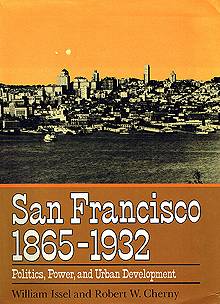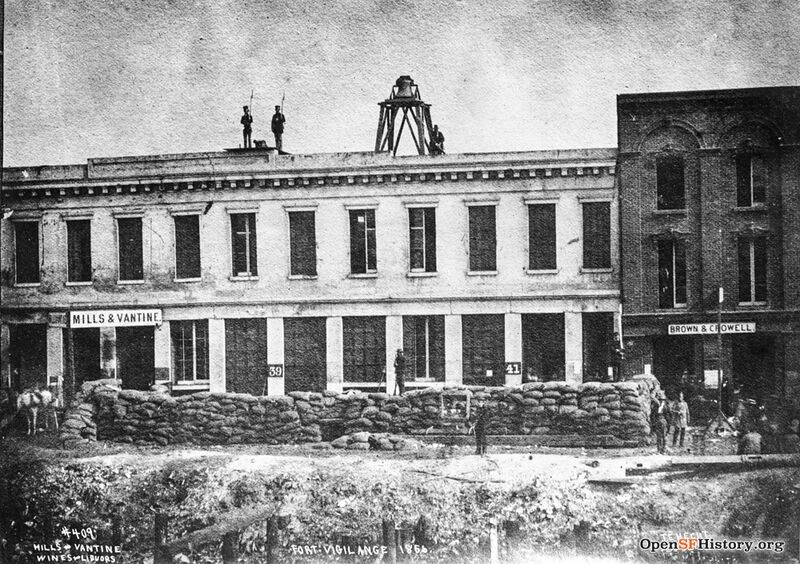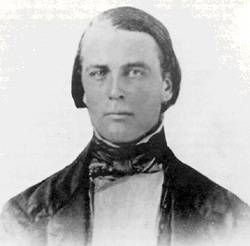Politics and the Vigilance Committees
Historical Essay
by William Issel and Robert Cherny
continued from part two
Also called Fort Gunnybags, south side of Sacramento St. between Front and Davis. Headquarters of vigilantes. Bell and guards on top of building. Where Casey and Cora were hanged. Brown & Crowell.
Photo: OpenSFHistory.org. Published in 1856, G.R. Fardon's San Francisco Album
Businessmen tended to dominate San Francisco's associational life just as they controlled most of the city's wealth. When volunteer fire companies emerged in response to the disastrous fires in the congested business district near the cove, merchants took leadership roles, and their names filled well over half the spaces on the membership lists. When churches and synagogues began to show themselves on the city skyline, merchants led the congregations, and when militia companies drilled and paraded in Portsmouth Square, merchants gave the orders. Members of the business community also presided over the city’s political institutions as they gradually decided that they needed to guide the choice of candidates for political office, change the structure of municipal government, and alter the contents of public policy. This development was accompanied, however, by considerable, sometimes violent, controversy.(38)
The merchant reformers claimed to represent “the people” against a corrupt and inefficient one-party system dominated by politicians who put personal aggrandizement before public interest. Actually, San Francisco’s record of efficiency stood up quite well when compared with other American cities of the time, and corruption and financial mismanagement flourished in the private sector as well as in the public. The merchants claimed to uphold law and order against rampaging villains who respected neither business property nor family propriety. In fact, the committees of vigilance organized by the city’s merchants in 1851 and 1856 to establish control over municipal politics carried out reigns of terror that were flagrant violations of state and local legal codes. Several interrelated issues supplied the background to this period of political turmoil: impatience with the results of political party competition for local office; suspicion of Irish Catholic voters and mistrust of one particular Irish Catholic political broker who played the game to win and quickly established a successful record; desire to keep the tax burden as low as possible, even at the risk of short-changing city services; desire on the part of the merchants—and especially their wives— to stamp the city political system with the seal of family-centered respectability.(39)
During the gold rush boom of 1848 and 1849, visitors to San Francisco could expect to find almost anything but Victorian family respectability. The prospects of instant wealth that moved well-connected pre-gold rush merchants like William Howard to recommend migration to his relatives in Boston also lured hundreds of speculators from more obscure backgrounds. For Howard and other Protestant merchants used to exercising daily command over the affairs of the commercial village, appointment to the first city council and membership in the convention that drafted California’s first constitution seemed a logical extension of personal influence. Municipal government, from the standpoint of these men, ought to have been synonymous with inexpensive city housekeeping by the successful businessmen of the community.(40)
Similar convictions informed William Howard’s brother, George, who complained from Boston during the heated presidential campaign of 1844 that James Polk was “brought in by foreigners, mostly Irish who have been naturalized and paid to vote for him.” William Gay, another Boston correspondent, warned Howard a month later that unless Congress made drastic changes in the immigration laws, “we shall soon be ruled by the rabble and the mob.”
Not a boy in our public schools of 14 years of age but is better acquainted with the institutions of our country, and know wherein their interests lie, than nine out of ten of these ignorant, bigoted Irish who control the elections in our States. The Irish are making great inroads . . . and I trust our people will get their eyes open before it is too late.(41)
The phobia against foreign influence expressed by George Howard and William Gay existed wherever American commercial cities attracted Irish immigrant workers during the late 1840s. But the anxieties felt by New Englanders about the future of their Protestant culture did not lessen their zeal for exporting it to San Francisco. William Henry Thomas and his group traveled to San Francisco in 1849 with the advice of Edward Everett, president of Harvard College, ringing in their ears: Go with “the Bible in one hand and your New England civilization in the other, and make your mark on the people and the country.” The Reverend Timothy Dwight Hunt wanted to go even further and “make California the Massachusetts of the Pacific.” Twenty-two-year-old Robert B. Wallace, son of a Pennsylvania state government auditor, apparently took such admonitions seriously. He was impressed by the “splendid buildings equal to our eastern cities” that he found in San Francisco in 1852. He complained to his father, however, that “everything is to captivate the senses, but to me it is disgusting.”(42)
David Broderick, a stonemason's son whose Roman Catholic father had been born in Ireland, defined the relationship among personal culture, political success, and public affairs in a different way from William Howard. Broderick’s experience of leadership had come from the militaristic rough and tumble of New York City ward politics, and for Broderick the logical vehicle for achieving personal success and exercising public influence had been the Democratic party. Broderick’s belief that the Democratic party ought to be considered the legitimate vehicle for the exercise of municipal government matched the belief of most of the large number of Irish Catholic voters. Their change of address had not changed their conviction that party politics offered the most efficient means of achieving desirable city policy and that the party most suited to Irish Catholic ends remained the party of Jefferson and Jackson.(43)
During 1849 and 1850, as Broderick and other professional politicians began to develop a party organization capable of turning out loyal voters and controlling officeholders, the leaders of the city’s merchant community carried out the first of three experiments in extralegal government. Affronted by the way in which the Hounds, a group of mercenaries hired by businessmen to protect property and maintain order, had exceeded their charge and themselves become a public menace, a 230-man committee led and organized by the merchants arrested the Hounds. Dissatisfied with the record of the mayor, the committee appointed its own representatives ostensibly to help him judge the Hounds, thereby overriding the legally constituted authorities and establishing a precedent for the future.
The establishment of official city charters in 1850 and 1851 symbolized a movement away from frontier informality and toward institutionalized mechanisms of municipal administration. The April 1851 elections illustrated the extent to which some of the volatile issues of New York and Boston politics had successfully made the journey to San Francisco. The Broderick Democrats had by then established a viable vote-getting organization, whose methods sometimes bordered on fraud and skirted the edge of bribery. Their opponents had begun to fight back by insisting that the body politic stood in danger of ruin by “wild Irishmen.” Issues of real estate development constituted the lifeblood of much day-to-day politics during this period, and tensions increased as those real estate speculators whose interests suffered because of decisions of Democratic party judges made charges against the corruption of the political system. These allegations about the legitimacy of the courts, combined with outrage over a robbery and the large number of thefts that accompanied a fire in May, moved merchants to establish a Committee of Vigilance in June 1851. The committee purposely excluded blue-collar workers, accused the predominantly Irish immigrants from Australia known as “Sydney Ducks” of being particularly prone to criminal behavior, hanged four men, banished fourteen from the city, and turned fifteen over to city authorities. The committee, numbering some five hundred, stayed active until the autumn when it demonstrated its political side by nominating a slate of independent candidates for the September elections.(44)
William Coleman, leader of 1856 Vigilance Committee, and the Pickhandle Brigade of 1877.
Image: San Francisco History Center, San Francisco Public Library
Dramatic as it was, the 1851 committee turned out to be only a dress rehearsal for a more comprehensive vigilante episode led by William Coleman five years later. Between these two outbreaks of “frontier justice,” the city’s Democrats, although beset by challenges from the Whig and then the American (anti-foreigner) parties, nonetheless continued to attract the majority of the votes from the city’s working-class neighborhoods and its Irish Catholics. Critics correctly accused the Democrats of fraudulent election practices, but their complaints that David Broderick had made the city into his personal fiefdom and that he had terrorized opposition newspaper editors and voters into quiet subservience were, in the words of historian Roger Lotchin, “totally absurd.” Absurd or not, such rhetoric about the tyranny over the popular masses by the Democratic few became the justification for what Robert Burchell has called “a very neat surgical operation on the body politic” by the 1856 Committee of Vigilance. Once again, as in 1851, a violent crime provided the spark that ignited the rush to extralegal judgment. This time it was the murder of a newspaper editor who had been especially lionized by politically savvy and socially active wives of San Francisco merchants and professional men. This time, however, vigilante activists generated an active opposition in the form of a Law and Order Committee with a heavily Irish membership, and permanent control over the city’s political institutions became necessary for the vigilantes’ own self-protection.(45)
Despite this opposition, the vigilantes managed to deport almost three dozen of the Democratic activists and to discredit their party under the guise of cleaning up the city. As before, the Committee of Vigilance fielded a slate of candidates, this time under the banner of a “People’s party,” for the fall elections. The reform slate was swept into office by a two-to-one majority with middle-class family neighborhoods providing a heavier vote for the new party than the districts near the waterfront. Only the downtown working-class First District remained loyal to the Democrats.
Once in office, the new government instituted a typical set of mid-century business reforms: fiscal policies designed to minimize the tax rate and maintain the city’s reputation among merchants in the East and political policies designed to minimize participation in nominations and elections by unmarried, unpropertied, and heavily Irish Catholic members of the working class. Many of the Irish Democrats dropped out of politics after 1856, though many others continued to campaign for, and occasionally win, election to the Board of Supervisors. The prestige position of mayor went only to Protestant merchants until after the Civil War, and the legacy of the People’s party dominated the San Francisco scene for nearly twenty years. By the time the Civil War began in 1861, the city had experienced nearly four years of government by the self-styled reformers of the Peoples party. Although they governed the city under the charter that had been partly written by the discredited Broderick Democrats in 1855, the vigilantes and their defenders wrote the history of the 1856 days according to the plot that made the merchants into heroic defenders of urban virtue. The Broderick Democrats appeared as rogues and “politicians," assigned to the lower reaches of the human species.(46)
Disagreements about the legitimacy of what participants continued to call “the revolution" of 1856 persisted nonetheless. William Tecumseh Sherman, a San Francisco banker at the time, had opposed the vigilantes and supported the Law and Order Committee. Years later, in a letter to lawyer John Doyle, Sherman repeated his doubts that “merchants are more to be trusted in the principles of justice than Coke, Blackstone, Kent, etc., etc.”
In 1856 at San Francisco Judge Norton was as good as any Judge today in St. Louis. The Grand Jury as fair and the petit Jury as reliable, yet it stands recorded in history that all were corrupt, and the community was compelled by a sense of self protection to take justice into its own keeping. They were successful, and “Success is Success."(47)
The political offshoot of the Committee of Vigilance, the People’s or Taxpayers’ party, maintained its hegemony during the Civil War years. San Francisco merchants shared in the business boom brought on by the Civil War, as did all of the city's population. By maintaining loyalty to both the Union and the gold standard and by banning greenbacks from the city, merchants could buy goods selling for $1.70 to $2.50 in paper money for a dollar's worth of gold. They invested the profits in the newly discovered Nevada silver mines or in California real estate. The city’s merchants also profited from the sudden demand for California's agricultural goods, as production soared from $29,000 in 1859 to almost $3 million in 1861. The high cost of transportation and the new protective tariffs passed by the Republicans stimulated a more diversified manufacturing sector. Capital invested in industry increased ten times during the decade 1860-1870, the industrial work force increased almost twenty times, and the value of manufactured goods almost four times.(48)
By the time the nation took up the burden of Reconstruction in 1866, San Francisco stood poised on the brink of regional urban leadership and national prominence. The completion of the transcontinental telegraph in 1861, the passage of the Pacific Railway Act in 1862, the establishment of the Bank of California in 1864, and the opening of the San Francisco and San Jose Railroad in the same year provided visible evidence of the city’s key position in the West and its growing importance in the nation.
Notes
38. See Decker, Fortunes and Failures, pp. 120–143.
39. See Lotchin, San Francisco, pp. 160–163, 230–239, 245–275.
40. Decker, Fortunes and Failures, p. 108.
41. George Howard to William Howard. Nov. 2, 1844; William B. Gay to William Howard, Dec. 3. 1844, in William D. M. Howard Papers, California Historical Society. San Francisco.
42. George R. Stewart, Take Your Bible in One Hand: The Life of William Henry Thomas (San Francisco. 1939). pp. 30–31; Timothy Dwight Hunt, Address Delivered Before the New England Society of San Francisco (San Francisco, 1853), p. 20, quoted in Luckingham, "Immigrant Life," p. 606; Robert B. Wallace to his father, June 16, 1852, Robert B. Wallace Letters. California Historical Society, San Francisco.
43. For a thorough analysis of Broderick and San Francisco politics, see David A. Williams, David C. Broderick: A Political Portrait (San Marino, CA, 1969).
44. Decker, Fortunes and Failures, pp. 123–125; Lotchin, San Francisco, pp. 192–201. Lotchin points out that the committee’s claim to have created peace and tranquility was overstated and that it sometimes applied a double standard; see pp. 200–201.
45. Lotchin, San Francisco, p. 225; Burchell, San Francisco Irish, p. 129. Robert B. Wallace, aide to William T. Coleman and his second in command during “the revolution" of 1856, was still convinced in 1860 that “a fall back to old ways would be certain death to many of us in San Francisco”; letter from Robert B. Wallace, March 4, 1860 (first page with addressee missing), Robert B. Wallace Letters, California Historical Society, San Francisco.
46. Steven P. Erie, “The Development of Class and Ethnic Politics in San Francisco, 1870–1910: A Critique of the Pluralist Interpretation,” Ph.D. dissertation, University of California, Los Angeles, 1975, pp. 110–114; Burchell, San Francisco Irish, pp. 131 — 154.
47. William T. Sherman to John T. Doyle, Jan. 4, 1884, William Tecumseh Sherman Letters, California Historical Society, San Francisco; for a defense of the committee by one of its leading merchant supporters, see the statement (n.d.) by Frederick William Macondray, Jr., in the Frederick William Macondray, Jr., Papers, California Historical Society, San Francisco.
48. Decker, Fortunes and Failures, pp. 147-150.

Excerpted from San Francisco 1865-1932, Chapter 1 “Commercial Village to Coast Metropolis”


